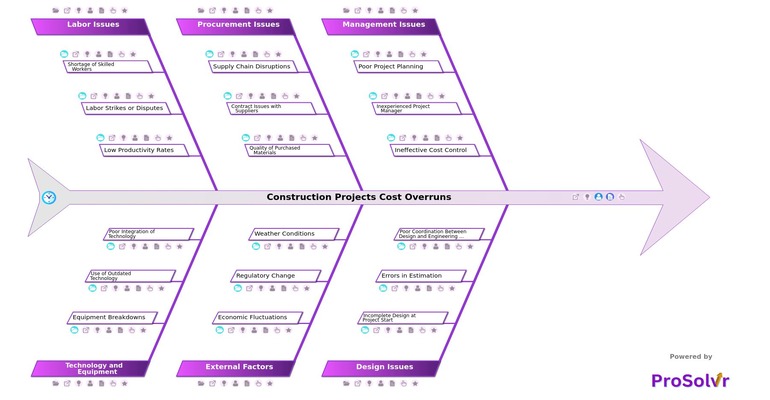RCA of Construction Projects Cost Overruns
Cost overruns are a common issue in construction projects, leading to delays and financial stress. Conducting a Root Cause Analysis (RCA) is essential for identifying the underlying reasons and developing effective Corrective and Preventive Actions (CAPA). By focusing on areas such as scope management, cost estimation accuracy, scheduling, and project management, teams can better understand the root causes and implement solutions.
One of the primary factors leading to cost overruns is scope creep, where changes to the project scope occur without proper approvals. This expands the project beyond its initial boundaries, resulting in increased costs and delays. Collaborative RCA tools can help teams manage and control scope changes more effectively, reducing the risk of budget overruns.
Inaccurate cost estimations during the planning phase also contribute significantly to cost overruns. Poor budget forecasting or insufficient contingency planning for unforeseen expenses can cause financial strain later in the project. By bringing together diverse insights during RCA, teams can improve estimation accuracy and ensure that adequate buffers are built into the budget.
Schedule delays caused by external factors, such as adverse weather, labor shortages, or supply chain disruptions, frequently extend project timelines and inflate costs. Collaborative project management and scheduling systems help teams plan for contingencies, adjust timelines in real-time, and allocate resources efficiently to mitigate these delays.
Weak coordination and communication gaps, often leads to resource inefficiencies, increasing costs. Improved collaboration among project teams, using tools that foster better communication, ensures smoother execution and minimizes mismanagement risks.
Fluctuating material prices and unreliable subcontractors, also impact project budgets. Collaborative risk management helps teams anticipate and mitigate these issues through better planning and supplier management strategies.
Addressing cost overruns in construction projects requires a comprehensive approach, supported by collaborative RCA and CAPA implementation. Platforms like ProSolvr enable teams to work together efficiently, fostering transparency and shared accountability, which are crucial for tackling cost overruns and ensuring more predictable project outcomes.
Who can benefit from this template?
The Root Cause Analysis (RCA) of construction project cost overruns is invaluable for a broad range of stakeholders involved in the planning, execution, and management of construction projects.
- Project Managers: Use RCA to identify cost drivers and improve planning, resource allocation, and decision-making, reducing delays and cost overruns.
- Construction Executives & Owners: Leverage RCA to understand systemic issues and implement strategic changes, ensuring long-term profitability and reputation maintenance.
- Project Engineers & Architects: Benefit from RCA by pinpointing design and technical errors that lead to costly revisions, enhancing overall design accuracy.
- Procurement & Supply Chain Managers: Apply RCA to improve supplier selection, contract management, and optimize material delivery, minimizing delays and associated costs.
- Financial Controllers & Budget Analysts: Refine financial tracking and ensure adherence to budgets, reducing financial risks through more accurate cost control.
- Contractors & Subcontractors: Identify labor and material inefficiencies using RCA, which helps optimize usage and improve project timelines.
- Construction Site Supervisors: Enhance operational efficiency and on-site resource management by addressing inefficiencies discovered through RCA.
- Risk Management Teams: Use RCA to implement robust risk mitigation strategies, reducing vulnerabilities that lead to cost overruns.
- Clients & Investors: Monitor project performance and ensure accountability, using RCA to gain transparency into cost drivers and financial management.
- Legal & Contract Management Teams: Resolve contract disputes and enforce terms by understanding the causes of cost escalations, preventing future issues.
RCA empowers each stakeholder to proactively manage and minimize cost overruns, improving project outcomes and ensuring smoother project execution.
Why use this template?
- Identify Underlying Issues: RCA uncovers the root causes of cost overruns, such as poor planning, miscommunication, or procurement delays, ensuring that stakeholders address the real issues instead of the symptoms.
- Prevent Future Overruns: By implementing Corrective and Preventive Actions (CAPA) based on RCA findings, organizations can proactively reduce the likelihood of future cost overruns, ensuring smoother project completion.
- Improve Efficiency and Productivity: RCA helps identify inefficiencies in project management, labor, equipment usage, and procurement processes, driving cost savings and enhancing productivity.
- Enhance Decision-Making: With RCA’s detailed insights into cost drivers like design errors or financial mismanagement, project managers can make more informed decisions that keep projects within budget.
- Increase Accountability and Transparency: RCA establishes a clear framework for determining responsibility for cost overruns, fostering transparency and accountability across all levels.
- Boost Stakeholder Confidence: Demonstrating a commitment to cost control through RCA builds trust among clients, investors, and regulators, reinforcing confidence in a company’s ability to deliver projects on time and within budget.
- Ensure Legal and Contractual Compliance: RCA provides clarity on contract disputes related to cost overruns, supporting stronger contract management and reducing the risk of litigation.
Using RCA for construction project cost overruns enhances project performance, prevents financial losses, and fosters a culture of continuous improvement.
Draft and create a template for problem analysis in ProSolvr by smartQED.
Curated from community experience and public sources:








